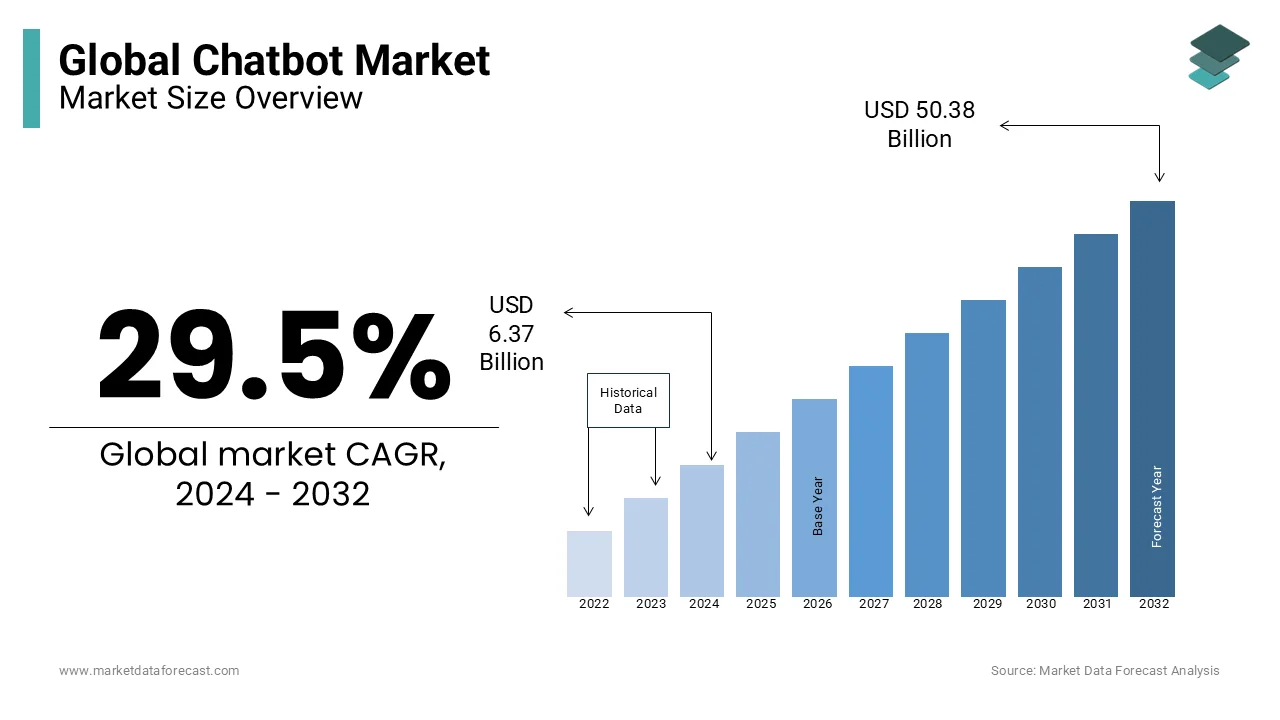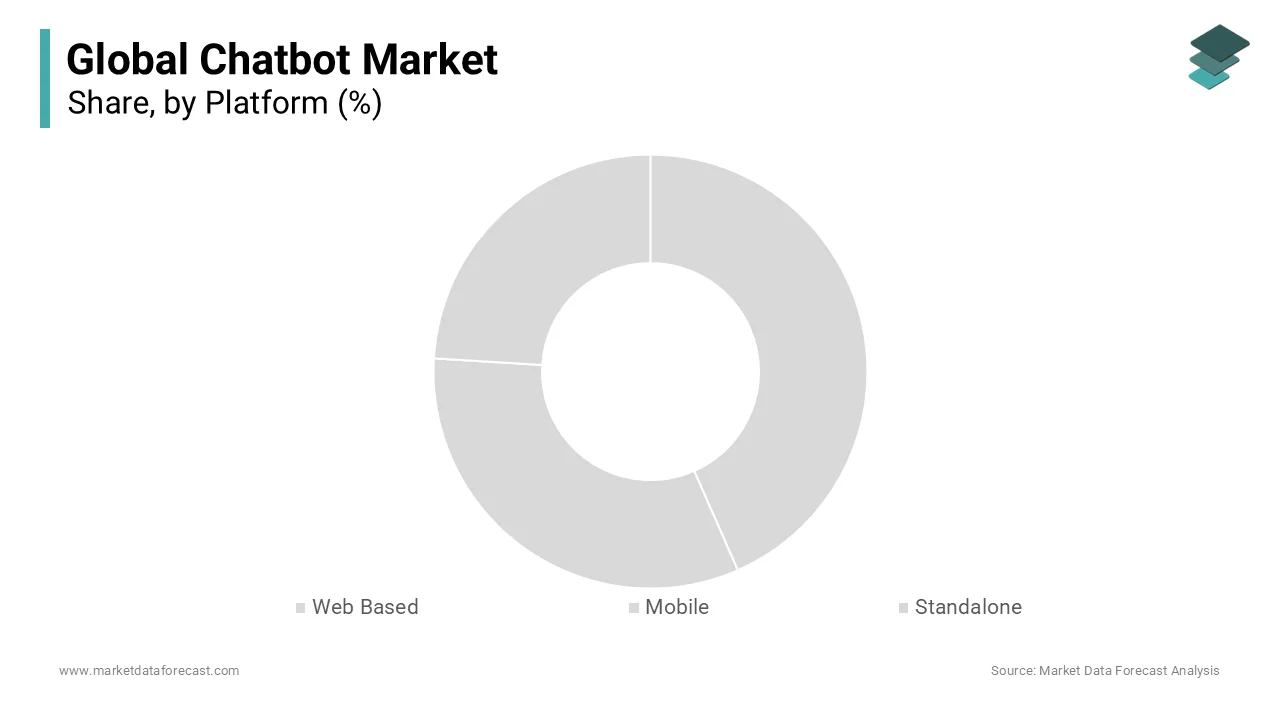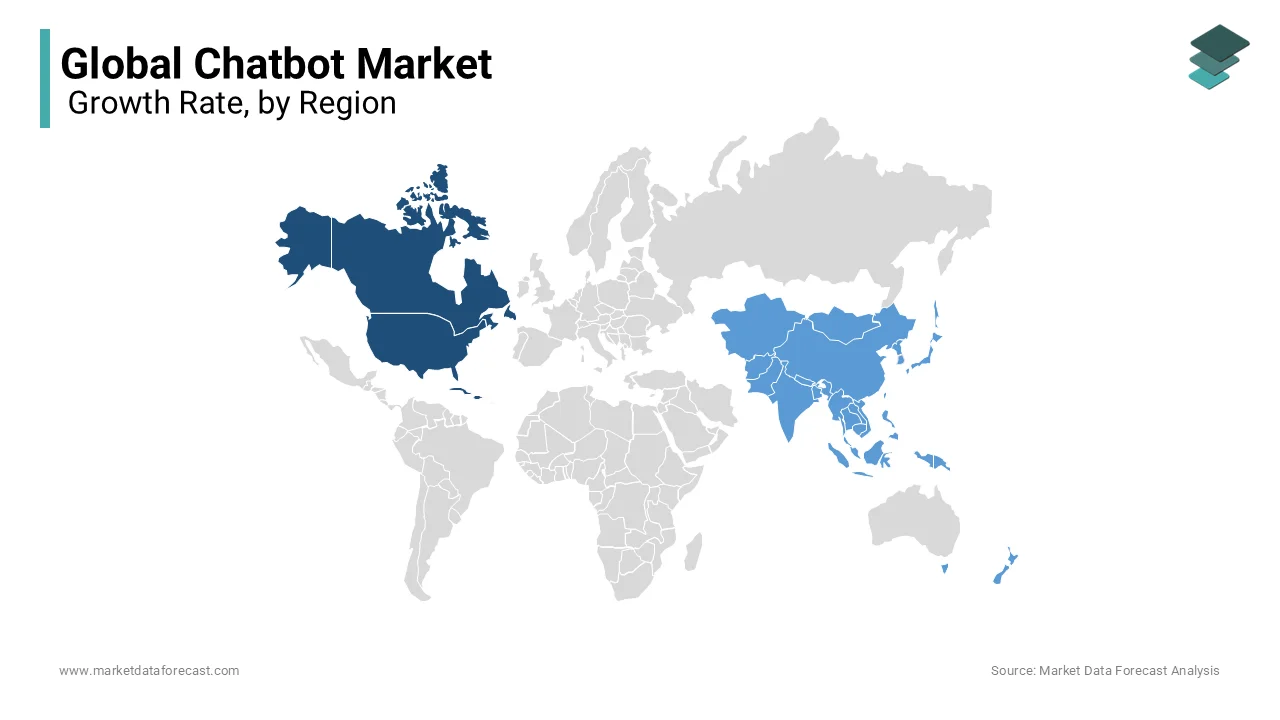Global Chatbot Market Size, Share, Trends, & Growth Forecast Report By Platform (Web-Based, Mobile and Standalone); Enterprise Size (Small and Medium Enterprises, Large Enterprises); End-User (BFSI, Healthcare, Travel and Hospitality, Government, Educational Institutions, and Others) & Region - Industry Forecast From 2025 to 2033
Global Chatbot Market Size
The global chatbot market was worth USD 6.37 billion in 2024. The global market is predicted to expand from USD 8.25 billion in 2025 to USD 65.25 billion by 2033, at an annual expansion rate (CAGR) of 29.5% during the forecast period.

A chatbot is an artificial intelligence (AI) based software that can make a human language conversation through messaging apps, websites, mobile, or other platforms. The report covers various end-user segments, such as BFSI, healthcare, travel and hospitality, government and others, where chatbots are implemented in various geographies.A chatbot is essentially an application based on artificial intelligence that talks to a human to solve a problem or respond to a certain request. This reduces uptime and improves efficiency, which helps market growth. According to Salesforce, 69% of consumers prefer to use chatbots because of the speed at which they can communicate with a brand. Additionally, the demand for voice-activated smart devices is gaining popularity due to high convenience and fully automated processes. In January 2020, Google introduced its AI-based chatbot, Meena. It is a multi-turn open domain chatbot formed end-to-end on the extracted data. Meena's neutral network contains around 2.6 billion parameters. Chatbots are poised to grow at a significant rate, so companies are poised to embrace the technology in their existing business portfolio. According to MIT Technology Review, 90% of the companies reported faster resolution of robot complaints.
MARKET TRENDS
Artificial Intelligence (AI) mass adoption rate has been used to focus on customer satisfaction with the introduction of ChatBots. Healthcare providers continually work with ChatBot companies to better help patients. The average number of patients spends around 30 minutes trying to find the right service that their local hospital can provide, and the average nurse spends 1 hour a day trying to connect with the right doctor.
Major healthcare systems use chatbots to facilitate fully conversational discovery of their services and enable seamless planning for their patients. With similar ease, vendors can now track specialists and set benchmarks through a single conversation with the help of conversational AI agents. For example, Gyant's chatbot asks patients to understand their symptoms, then sends the data to doctors, who provide diagnoses and prescribe drugs in real time. In March 2019, the company said it had pushed more than 785,000 people in Latin America to pass a diabetes test.
Healthcare providers are nowadays implementing these chatbots to interact with their patients about recent procedures and information on chronic illnesses like diabetes, cardiovascular disease, arthritis, etc., which is supposed to increase patient satisfaction and decrease readmissions. In a healthcare space, chatbots provide simplicity and convenience to consumers, helping to improve workforce, productivity and consumer connection for providers. For instance, Northwell Health chatbots help patients in cancer care, and Premera Blue Cross introduced its Premera Scout chatbot to assist patients in their treatment. Additionally, the Mayo Clinic is digging into the technology by investigating voice-activated robots.
In the current market scenario, there are various mobile applications that use AI for chat bots or image analysis facilities, which are increasingly popular among mobile users. For example, take the case of Babylon, a leading AI-based mobile app that allows users to use a smart chatbot to help and link symptoms and communicate with an affected doctor via video chat.
MARKET DRIVERS AND RESTRAINTS
Some of the key factors driving the growth of the global chatbot market are the increasing demand for chatbots across various industry verticals and the focus on improving customer engagement through artificial intelligence-based chatbots. However, among the various factors responsible for slowing the growth of the chatbot market, the technological competence to host and support the functioning of the chatbot in order to provide a smooth user experience is of great importance.
REPORT COVERAGE
|
REPORT METRIC |
DETAILS |
|
Market Size Available |
2024 to 2033 |
|
Base Year |
2024 |
|
Forecast Period |
2025 to 2033 |
|
CAGR |
29.5% |
|
Segments Covered |
By Platform, End User, Company Size, and Region |
|
Various Analyses Covered |
Global, Regional & Country Level Analysis, Segment-Level Analysis, DROC, PESTLE Analysis, Porter’s Five Forces Analysis, Competitive Landscape, Analyst Overview on Investment Opportunities |
|
Regions Covered |
North America, Europe, APAC, Latin America, Middle East & Africa |
|
Market Leaders Profiled |
IBM Corporation (USA), Nuance Communications (USA), Google (USA), Amazon Web Services (USA), Artificial Solutions (Spain), Inbenta Technologies (USA), [24] 7 .ai (USA), Chatfuel (USA), AIVO (Argentina), Botsify.com (Pakistan), Passage AI (USA), Kore.ai (USA), KeyReply (Singapore), SmartBots (USA), Contus (India), Yellow Messenger (India), CogniCor Technologies (USA), Conversica (USA), Gupshup (United States) and Kevit (India) Others. |
SEGMENTAL ANALYSIS
By Platform

REGIONAL ANALYSIS

North America is a major contributor to the global chatbot market revenue. Additionally, the region is expected to be the fastest-growing segment during the forecast period. Growth in the region is mainly driven by demand from countries like the United States and Canada. The Asia Pacific region is foreseen to expand with a considerable CAGR in the coming years.
KEY MARKET PLAYERS
IBM Corporation (USA), Nuance Communications (USA), Google (USA), Amazon Web Services (USA), Artificial Solutions (Spain), Inbenta Technologies (USA), [24] 7 .ai (USA), Chatfuel (USA), AIVO (Argentina), Botsify.com (Pakistan), Passage AI (USA), Kore.ai (USA), KeyReply (Singapore), SmartBots (USA), Contus (India), Yellow Messenger (India), CogniCor Technologies (USA), Conversica (USA), Gupshup (United States) and Kevit (India) Others.
RECENT MARKET HAPPENINGS
-
In April 2020, IBM, with its Watson Assistant chatbots, is helping government agencies, healthcare organizations, and academics around the world to use artificial intelligence to put critical data and information in the hands of their citizens.
-
In February 2020, Creative Virtual has a partnership with Spitch AG, the leading developer of enterprise voice solutions in Switzerland. The collaboration will use the best technologies from both companies to provide their clients with innovative self-service solutions. The integration of Creative Virtual's V-Person natural language chatbots and Spitch voice technology brings to the market a leading-edge voice bot offering.
MARKET SEGMENTATION
This research report on the global chatbot market has been segmented and sub-segmented based on the platform, end-user, company size, and region.
By Platform
- Web Based
- Mobile
- Standalone
By End-User
- BFSI
- Healthcare
- Travel and Hospitality
- Government
- Educational Institutions
- Others
By Company Size
- Small and Medium Enterprises
- Large Enterprises
By Region
- Asia Pacific
- Europe
- Middle East and Africa
- North America
- Latin America
Frequently Asked Questions
How are advancements in AI impacting the chatbot market?
Advancements in AI, particularly in natural language processing (NLP) and machine learning (ML), are enhancing the capabilities of chatbots to understand and respond to user queries more intelligently. This leads to improved customer satisfaction and increased efficiency in operations across industries.
What types of chatbots are most commonly used in the market?
The market comprises rule-based chatbots, AI-based chatbots, and hybrid chatbots. AI-based chatbots, leveraging machine learning and natural language processing, are gaining significant traction due to their ability to provide more sophisticated and context-aware responses.
What role do chatbots play in enhancing business productivity?
Chatbots streamline various business processes by automating repetitive tasks, handling routine inquiries, qualifying leads, and providing data insights through analytics. This frees up human resources to focus on more complex and value-added activities, thereby enhancing overall productivity.
How do regulatory frameworks impact the deployment of chatbots globally?
Regulatory frameworks, particularly concerning data privacy and protection laws such as GDPR in Europe and CCPA in California, influence how organizations collect, store, and process data through chatbots. Compliance with these regulations is essential to ensure trust and mitigate legal risks associated with chatbot deployment.
Related Reports
Access the study in MULTIPLE FORMATS
Purchase options starting from
$ 2500
Didn’t find what you’re looking for?
TALK TO OUR ANALYST TEAM
Need something within your budget?
NO WORRIES! WE GOT YOU COVERED!
Call us on: +1 888 702 9696 (U.S Toll Free)
Write to us: sales@marketdataforecast.com